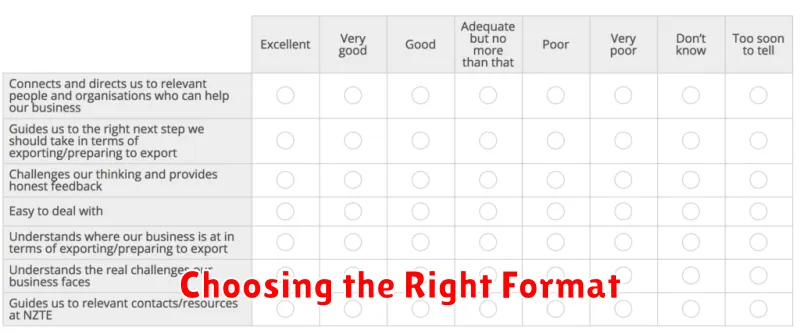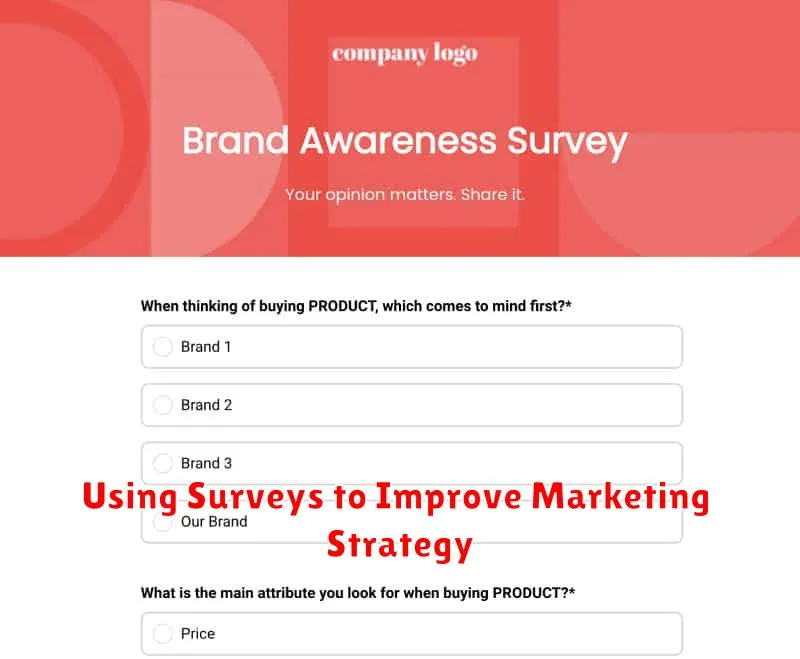Marketing strategy is crucial for any business seeking growth and success. Developing a robust and effective strategy requires a deep understanding of your target audience, their needs, preferences, and behaviors. One powerful tool that can provide these valuable insights is market research surveys. By leveraging surveys, businesses can gather essential data that inform strategic decisions, optimize marketing campaigns, and ultimately improve overall marketing strategy effectiveness. Using surveys effectively can help you identify market trends, understand customer satisfaction levels, and refine your messaging for optimal impact. This article will delve into the practical applications of surveys for marketing strategy improvement, providing a roadmap to effectively harness the power of data-driven decision-making.
From crafting targeted marketing campaigns to enhancing customer relationship management, the applications of surveys in marketing are vast. Learn how to design effective survey questionnaires, select the right survey methodology (online surveys, email surveys, etc.), and analyze the collected data to extract actionable insights. By implementing the strategies outlined in this article, you can empower your business to make informed decisions, refine its marketing strategies, and achieve sustainable growth through a deeper understanding of your target market. This guide to using surveys to improve marketing strategy will provide you with the tools and knowledge to leverage market research surveys for maximum impact.
Why Feedback Matters
In the realm of marketing, understanding your target audience is paramount. Feedback provides crucial insights into consumer perceptions, preferences, and needs, allowing businesses to tailor their strategies for maximum effectiveness. Without it, marketing efforts can become misdirected and ultimately fail to resonate with the intended audience.
Effective marketing strategies are built upon a foundation of data. Feedback, gathered through various channels like surveys, provides this essential data. It helps businesses understand what aspects of their marketing are working well and what areas require improvement. This data-driven approach minimizes guesswork and allows for more informed decision-making, leading to better resource allocation and a higher return on investment.
Customer satisfaction is a key indicator of a successful marketing strategy. Feedback mechanisms like surveys provide a direct line to understanding customer satisfaction levels. By actively soliciting and addressing customer feedback, businesses can identify and rectify potential issues, ultimately fostering loyalty and driving positive word-of-mouth marketing.
Designing Effective Survey Questions
Well-designed survey questions are crucial for gathering reliable and actionable data. Ambiguous or leading questions can skew results and render the entire survey useless. Start by clearly defining your survey’s objectives. This will guide your question formulation and ensure relevance.
Choose the appropriate question types. Closed-ended questions (multiple-choice, rating scales) offer structured responses, making analysis easier. Open-ended questions provide richer qualitative data but require more effort to analyze. Use a mix of both to gain a comprehensive understanding.
Keep questions concise and focused, avoiding jargon or technical terms your audience might not understand. Use neutral language to avoid leading respondents towards a particular answer. For example, instead of asking “Don’t you think our product is great?”, ask “How would you rate the quality of our product?”.
Test your survey with a small group before distributing it widely. This pilot test can help identify confusing questions or technical issues, ensuring the final survey is effective in gathering the data you need.
Choosing the Right Format

Selecting the appropriate survey format is crucial for gathering effective data. The format influences respondent engagement and the type of data collected. Consider your target audience and the complexity of the information you need.
Multiple choice questions are excellent for collecting quantifiable data and are easy for respondents to complete. Open-ended questions provide richer qualitative insights but require more effort from participants and can be more challenging to analyze. A combination of both often provides a balanced approach.
Rating scales, like Likert scales, allow respondents to express degrees of agreement or satisfaction. Ranking questions help understand priorities among a set of options. Matrix questions are efficient for collecting data on multiple items with similar rating scales.
Keep the survey concise and focused to encourage completion. Mobile compatibility is essential for reaching a broader audience. Test the survey with a small group before launching it to identify any potential issues.
Distribution Channels for Surveys
Selecting the right distribution channels is crucial for reaching your target audience and maximizing survey participation. Several options are available, each with its own advantages and disadvantages.
Email remains a popular choice due to its wide reach and ease of use. It allows for targeted distribution to specific customer segments. However, email surveys can suffer from low open and response rates.
Online survey platforms such as SurveyMonkey or Qualtrics offer a streamlined approach to survey creation and distribution. They provide features like branching logic and data analysis tools. Consider the cost and platform features when choosing this option.
Social media platforms like Facebook and Twitter can be useful for reaching a broad audience quickly. However, responses may be less representative of your target market due to the platform’s diverse user base.
SMS surveys offer a direct and immediate way to gather feedback, particularly for mobile users. Keep in mind that SMS surveys are limited in length and complexity.
In-person surveys, while more resource-intensive, allow for deeper engagement with respondents and can yield richer qualitative data. This method is best suited for smaller, targeted groups.
The optimal approach often involves a multi-channel strategy, combining several methods to maximize reach and response rates. Carefully consider your target audience, survey objectives, and budget when selecting distribution channels.
Incentivizing Participation
Incentives can significantly improve survey response rates. Offering something of value in exchange for a respondent’s time shows appreciation and encourages completion. Choosing the right incentive depends on your target audience and survey length.
Common incentives include gift cards, discounts on future purchases, entry into a raffle or contest, charitable donations in the respondent’s name, and free samples or trials of products. The value of the incentive should be commensurate with the effort required to complete the survey. A short survey might warrant a smaller incentive, while a longer, more in-depth survey would benefit from a more substantial offer.
Clearly communicate the incentive upfront, explaining how and when respondents will receive it. Ensure the redemption process is simple and transparent. Consider the legal and ethical implications of offering incentives, especially concerning data privacy and contest regulations.
Analyzing Results for Actionable Insights
After collecting survey responses, the next crucial step is analysis. This involves transforming raw data into actionable insights that can inform marketing decisions. Begin by cleaning the data, ensuring accuracy and consistency. This may involve removing incomplete responses or correcting errors.
Then, employ various analytical techniques. Descriptive statistics like mean, median, and mode can summarize responses and identify trends. Cross-tabulation helps uncover relationships between different variables, such as demographics and purchasing behavior. For example, you might find that a specific age group prefers a particular product feature.
Look for statistically significant results, which indicate genuine trends rather than random chance. These insights can inform decisions regarding product development, pricing strategies, and promotional campaigns. For instance, if survey data reveals a strong preference for a specific feature, emphasize this in your marketing materials.
Finally, clearly communicate the findings. Use visualizations like charts and graphs to present the data effectively to stakeholders. This aids in making informed, data-driven decisions to improve marketing strategy.
Integrating Survey Data with Strategy
Integrating survey data into your marketing strategy is crucial for data-driven decision-making. It allows you to move beyond assumptions and base your actions on concrete customer feedback. This process involves several key steps.
First, analyze your survey data thoroughly. Identify key trends, patterns, and insights. Look for both positive and negative feedback to understand areas of strength and weakness.
Next, connect these insights to your existing marketing strategy. How does the data validate or challenge your current approach? Are there areas where adjustments are needed based on customer feedback?
Finally, implement changes based on your analysis. This might involve revising your messaging, targeting different demographics, or adjusting your product offerings. Continuously monitor the impact of these changes and further refine your strategy based on ongoing feedback.
By effectively integrating survey data, you can create a more customer-centric marketing strategy, leading to improved campaign performance and stronger customer relationships.
Closing the Loop with Respondents
Closing the loop with survey respondents is a crucial step often overlooked. It demonstrates respect for their time and reinforces their value in shaping your marketing strategy. This process involves acknowledging their participation and, where appropriate, sharing key findings and how their feedback is being used.
A simple thank you message immediately following survey completion is a good start. This can be automated within your survey platform. Consider a more personalized follow-up communication, perhaps through email, a few weeks later. This communication can briefly summarize key insights gleaned from the survey and outline planned actions. For instance, you might state, “Based on your feedback, we are prioritizing improvements to our website navigation.” This demonstrates that you are actively listening and taking concrete steps based on their input.
Closing the loop strengthens the relationship with your audience, fostering a sense of community and encouraging future participation in research initiatives. It also enhances your brand’s reputation for being customer-centric and responsive. This, in turn, can lead to increased customer loyalty and advocacy.
Avoiding Bias in Surveys
Bias in surveys can significantly skew results, rendering them unreliable for informing marketing strategy. It’s crucial to identify and minimize potential biases during survey design and implementation.
Sampling bias occurs when the respondent group doesn’t accurately represent the target population. For example, surveying only existing customers excludes potential customers and limits insights into broader market preferences. Employing stratified random sampling techniques can help mitigate this bias.
Question wording can introduce leading questions that subtly influence responses. For instance, “Don’t you think our product is great?” encourages positive answers. Use neutral language and avoid emotionally charged wording to obtain more objective data.
Response bias encompasses various factors influencing participant answers, such as social desirability bias, where respondents answer based on perceived social norms, and acquiescence bias, the tendency to agree with statements regardless of content. Offering anonymous responses and using balanced scales can help minimize these biases.
Tools for Survey Creation
Several tools can facilitate the creation and distribution of effective marketing surveys. These range from simple, free options to more sophisticated paid platforms offering advanced features. Selecting the right tool depends on your specific needs and budget.
Free or low-cost tools like Google Forms and SurveyMonkey (basic plan) are excellent for collecting basic demographic information, gauging customer satisfaction, or conducting simple market research. They offer easy-to-use interfaces with pre-built templates and basic reporting features. These tools are ideal for smaller businesses or individuals with limited resources.
For more complex surveys requiring advanced features like branching logic, skip patterns, and in-depth analysis, paid platforms like Qualtrics, SurveyGizmo, and Typeform are valuable. These platforms often provide advanced reporting and analytics tools, allowing for more sophisticated data interpretation and actionable insights.
When choosing a survey creation tool, consider factors like ease of use, available features, reporting capabilities, and integration with other marketing tools. The ideal platform will streamline your survey process from creation and distribution to analysis and implementation of findings.

